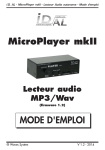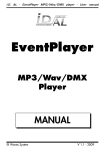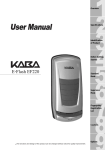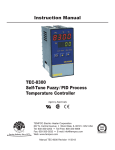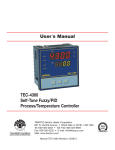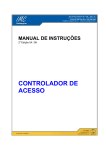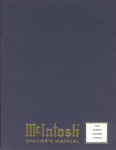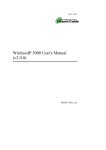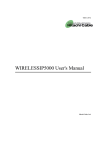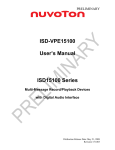Download Manuel VR4 FR - Solid State Sound
Transcript
I.D.AL - AP103 - MicroPlayer - Interactive MP3 Player - User Manual MicroPlayer MP3 Player MANUAL ® Waves System V 1.0 - 2007 I.D.AL - AP103 - MicroPlayer - Interactive MP3 Player - User Manual TABLE OF CONTENTS A - Safety instructions ............................................................................ P1 B - Products information ......................................................................... P3 1 - Product presentation ......................................................................... P4 2 - Functionnalities ................................................................................. P4 3 - Installation ........................................................................................ P5 4 - Operation mode and naming of files .................................................. P7 5 - Configuration file .............................................................................. P10 6 - RS232 serial link protocol ............................................................... P14 Appendix A - Correspondence .............................................................. P18 Appendix B - Specification ................................................................... P18 Appendix C - Functions ........................................................................ P19 ID-AL products are exclusively manufactured by Waves System LA VILLE EN BOIS - 44830 BOUAYE - FRANCE Sales and information: +33 2 40 78 22 44 E-mail : [email protected] Web site: http://www.id-al.com and www.wsystem.com Technical department : [email protected] Technical support : For a detailed list of the technical support options, we suggest you to visit our site www.id-al.com. Information in this manual is subject to change without notice and do not represent any commitment from Waves System. The equipment described in this manual is supplied under condition of the terms of license specifying the legal use conditions. This manual can’t be reproduced or used, in whole or in part, in any form and by any mean, for other use than private, without the written permission from Waves System. ID-AL is a trademarks of Waves System. ® Waves System V 1.0 - 2007 I.D.AL - AP103 - MicroPlayer - Interactive MP3 Player - User Manual WARNING: DO NOT EXPOSE TO MOISTURE AND DUST! Unplug the power cord before any intervention! FOR YOUR SAFETY, PLEASE READ CAREFULLY THIS OPERATION MANUAL BEFORE USING YOUR PLAYER. A. SAFETY INSTRUCTIONS A.1 CE marking The CE marking is on the ID plate, at the back of the product. It means this product complies with the low voltage CE directive, according the EN 55022 standard, and the EMC directive 61000-4-x. A.2 Directives • Electro-magnetic compatibility (EMC) and low voltage directive requirements are satisfied. A.3 Overview • The user’s manual forms an integral part of the unit. It must be kept close to the unit. Precise observance of these instructions is a pre-condition to use the unit for the intended purpose and for its correct operation. This user’s manual must be passed on to any future purchaser or operator. The staff would receive instructions concerning the correct use of the product. • Safety for the operator as well as trouble-free operation of the unit is only ensured if use is made of original equipment parts. Moreover, use may only be made of those accessories that are specified in the technical documentation or that have been expressly approved by the manufacturer. The manufacturer cannot guarantee for the safety or proper functioning of the unit in the case where accessories or consumables are used which are not supplied by the manufacturer. • The warranty doesn’t cover damages caused by use of accessories or consumables which are not supplied by the manufacturer. • The manufacturer only regard himself as being responsible for the equipment with regard to safety, reliability and proper functioning if assembly, re-settings, changes or modifications, extensions and repairs have been carried out by the manufacturer or a company authorized by the manufacturer and if the equipment is used in conformity with the operating instructions written in this manual. • The AP103 MicroPlayer complies with the applicable technical safety standards at the date of print. All rights reserved for electrical diagrams, procedures, mentioned names and equipments. • No reproduction, in whole or in part, without the written permission from Waves System. A.4 General safety instructions This equipment left our facilities in perfect conditions of operation. In order to maintain these conditions, for safety and to avoid any risk of injury, the user must imperatively follow the safety instructions and read the ´Warning!´ notes in this manual. This equipment, manufactured by Waves System, has been so designed that any danger is virtually excluded provided it is used according to its purpose. However, for safety reasons, we are obliged to point out the following measures: ® Waves System -1- V 1.0 - 2007 I.D.AL - AP103 - MicroPlayer - Interactive MP3 Player - User Manual • When operating this appliance, observe all local rules and enforced regulations! The homologation shall be invalid if any modification or alteration is made on the appliance. Operating modified appliances may lead to a penal suit. In the interest of the safety of work, the manager and the operator will be responsible for respecting the instructions. • Retain all packing material in case the device must be shipped. Take care that it does not fall into the hands of children. Only the original packing guarantees optimal safety of the appliance during transport. Should it be necessary to ship the product during the guarantee period, Waves System will not accept claims for damage arising during the transport from using incorrect packing material! • This product is dedicated to broadcasting music. It may only be operated by trained or knowledgeable personnel who can handle the device correctly. • Before every use, the operator must check the functional safety and the condition of the appliance. • The operator must be knowledgeable in the operation of the appliance. • This device must not be used in places with potential explosion risk. Moreover, it must not be used in an environment favouring combustion neither in a wet or excessively hot or cold place. A.5 Safety instructions against risks pertaining to electrical current • The appliance must be connected to a grounded AC power outlet or a correctly wired CEE AC outlet. • Before connecting the appliance, verify that the power supply voltage and frequency match the specifications indicated on the appliance. • Before powering, check that the appliance and the cables are not damaged. Damaged cables and connections must be immediately replaced. • Never leave power cords enter in contact with other cables! Handle the power cord and all the cables connected to a power supply with extreme care. • Always connect the power supply last. Check that the power switch is ´off’ before connecting the appliance to mains supply. The mains outlet must be accessible after installation. • Check the appliance and its power cord from time to time. Unplug the power supply if you don’t use the appliance anymore or for maintenance. • Always grasp only the plug on the power supply cord. Never pull the cable to unplug. • Power supply, repairs and maintenance must be done by qualified personnel. • Do not switch the appliance on and off in short intervals, as this may reduce its life, especially concerning the hard disk. ® Waves System -2- V 1.0 - 2007 I.D.AL - AP103 - MicroPlayer - Interactive MP3 Player - User Manual A.6 - Conditions of use : • This product has been designed for indoor use only. • If the device has been exposed to drastic temperature fluctuation (e.g. after transportation), do not switch it on immediately. The arising condensation water might damage your device. Leave the device switched off until it has reached room temperature. • Do not shake the device. Avoid brute force when installing or operating the device. • When choosing the installation-spot, please make sure that the device is not exposed to extreme heat, moisture or dust. There should not be any cables lying around, for your own safety and that of bystanders. B. PRODUCT INFORMATION B.1 Correct usage The player is designed for automatically broadcasting music or audio files. Correct usage implies observation of the instructions in this manual as well as observing the requirements concerning installation. B.2 Incorrect usage Any other use beyond this is considered as incorrect usage. The manufacturer will not be liable for any damage resulting from incorrect usage. The operator carries all risks. B.3 CONTENTS MP3 player - Model AP103 - MicroPlayer External power supply and power cable user's manual B.4 TECHNICAL SPECIFICATIONS MP3 player - Model AP103 External power supply : 12V DC - Input Voltage (V) 100-240 / Frequency (Hz) 50-60 B.5 INSTALLATION The apparatus must be set up in a dry and dust-free room. Do not install the player too close to a wall. To avoid overheating, the ventilation holes must be kept clear and an air circulation gap must be left above the unit. B.6 ELECTRICAL CONNECTION Before use, compare mains voltage with that specified on model plate. ® Waves System -3- V 1.0 - 2007 I.D.AL - AP103 - MicroPlayer - Interactive MP3 Player - User Manual 1 - Product presentation The MicroPlayer - ID-AL model AP103 - is an interactive MP3 player which reads MP3 files stored on a SD memory card. Playback can be automated to read files in loop or when triggered by one of the input contacts. The MicroPlayer is a versatile player designed for installations where broadcast of sounds, music, sound effects or commentaries are required such as museums, exhibitions, POS displays... 2 - Functionnalities Interactivity: The MicroPlayer is interactive, i.e it can be actioned by external events such as electrical contacts (4 contacts can be combined to provide up to 15 inputs), RS232 serial link commands (using protocole detailed in this manual), infrared remote control. Autoplay: This function is available on the MicroPlayer and it is configurable. When the Autoplay is activated, the player will automatically start playing the selected file or directory on powering on. Broadcast mode: The way files are organized and named on the SD card fully defines the broadcast mode. A seven digit code inserted in file and directory names provides powerful automation of playback programs. Updating: Either by removing the SD card from the player to transfer updates using a card reader or by connecting the player to a personal computer through the USB link to copy, delete, transfer or organize files. Audio output: Two audio outputs available. Line level stereo output on RCA to connect the player onto a sound system and amplified output on plug-in terminal block to connect directly onto speakers. The ouput power is sufficient for medium sized premises. Power supply: There are two power supply sockets - parallel connection - which can be used indiscriminately. The second socket can be used to feed the same input power to another player or any other device using the same voltage. The MicroPlayer is protected against polarity reversal. Caution, the Microplayer accepts variations between 10 and 15V. Outside this range, the player could be damaged. Amplifier output power is determined by the power supply. When the line level output is used a 500mA 6W unit is enough to power the MicroPlayer. If the integrated amplifier is used a 3.45A (45W) power supply unit minimum is required. If the supply unit has insufficient power, sound will be very bad and the power unit will heat up and eventually break down. ® Waves System -4- V 1.0 - 2007 I.D.AL - AP103 - MicroPlayer - Interactive MP3 Player - User Manual 3 - INSTALLATION 1 - USB socket - Update of SD card 2 - SD card slot 3 - Setting of volume + / 4 - Infrared detector 5 - Luminous indicator 2 4 3 5 1 6 - Power supply - 2 sockets used for the player and another device 7 - RS232 serial link 8 - Inputs on dry contacts 9 - Audio output on line level 10 - Amplified output for speakers 6 7 8 9 10 Memory card: choose a good quality card of a minimum size of 512Mo - New cards are usually formatted in «FAT» and you will have to re-format it in FAT32. The SD memory card must be formatted in FAT32 Other formats DO NOT WORK with the MicroPlayer. Push the card without forcing. To remove, push on the card to release it. Power supply: We recommand the use of the power supply unit provided with the player. If the application requires another power source or battery, it must be 12V DC, even though the player can accept tension between 8V and 15V. The consumption depends on the power of the amplifier. Connect the power supply unit to one of the 2 sockets. The second socket is wired in parallel to provide power supply for another MicroPlayer, a detector or any other device... ® Waves System -5- V 1.0 - 2007 I.D.AL - AP103 - MicroPlayer - Interactive MP3 Player - User Manual Note: There is no power switch on the MicroPlayer. The player is powered on as soon as connected. USB socket: When the MicroPlayer is connected to a computer with a USB cable, the MicroPlayer switches to the USB mode. The computer loads up the «Mass Storage driver to display the content of the memory card, as any external card reader would do. It is then possible to use any file manager tool such as Windows Explorer to copy, rename, delete, move files. Volume setting: Press on Volume + and Volume - buttons to adjust. Note, default volume level on powering on may be set in the configuration file. Infrared sensor: The MicroPlayer responds to orders sent by infrared remote controls (not supplied). Protocole and schematics are available on demand for special projects. Luminous indicator: a red LED displays the status of the player: LED off: the player is not powered or in low power mode LED on and fixed: the player is powered and awaiting for a command LED flashing quickly (2 flashes per second): the player is reading LED flashing slowly: Error signal - for example when memory card is empty RS232 Serial link: The MicroPlayer can be controlled by a computer, a controller, a serial remote control. The player receives data in on Rx and sends data out on Tx. The protocole is detailed further in this manual. IInputs on dry contacts: To trigger playback by action on various types of sensors, push buttons, detectors... Detailed description further in the manual. Create a quick contact between one input numbered 1 to 4 - and Ground G. It is also possible to combine the 4 contacts between one another to obtain up to 15 inputs ; in this case, it is recommanded to use a network of diodes. Refer to the appendices for more details. Audio output: To connect any device, amplifier, sound system... on line level. Speaker output: The MicroPlayer has an integrated amplifier and the speaker outputs provide connection for loud speakers: connect the speaker cables onto the 2 outputs of each channel. Caution: Never connect outputs between themselves, do not create short-circuits and do not use speakers with lower impedance than specified in the player specification. ® Waves System -6- V 1.0 - 2007 I.D.AL - AP103 - MicroPlayer - Interactive MP3 Player - User Manual 4 - Operation mode and naming of files Several playback modes are available, depending on the way files are organised and named on the SD memory card. 4.1 Basic mode On powering on, the MicroPlayer will read files placed at the root of the SD card. Do not create directories. Playback order will be the order the files have been copied into the card (first file copied, first file read). Playback of files in loop. All names made of letters and numbers are allowed, no special characters. Directories will be ignored. The Autoplay mode can be activated/deactivated in the «config» file. See related chapter. In this basic mode, the 4 input contacts are allocated to specific functions: Input 1 : Input 2 : Input 3 : Input 4 : Previous file Stop Play Next file A short electrical contact on the input actions the associated function. 4.2 Advanced mode The Microplayer offers an advanced operation mode where naming of files and directories and organization of the memory card determines the playback pattern. 4.2.1 Organization of directories: Only one level of directory from the root is allowed. File names are made of 7 digits (6 numbers + 1 letter) followed by the file name of your choice. Example : «001023R my directory» or «034034S directory name» The first 7 characters are composed of 2 blocks of 3 numbers followed by one letter. The first 3 numbers define the directory N° and therefore its name. ● Example : 000xxxx : Directory N° 000 - «Autoplay» directory read on power on. 001xxxx : Directory N° 001 034xxxx : Directory N° 034 The directory N° is used to define the playback order or specify the directory to «jump» to. ® Waves System -7- V 1.0 - 2007 I.D.AL - AP103 - MicroPlayer - Interactive MP3 Player - User Manual IMPORTANT: These 3 numbers are used to call up directories on activation on associated inputs. Input Input Input Input 1 2 3 4 : : : : Directory Directory Directory Directory 001 002 004 008 Simultaneous activation of several input contacts provide up to 15 combinations. Directory numbers N° 001 to 015 relate to input contacts 1 to 15 (binary combination) See table in appendix A. Special case: The directory 000xxxx is the name of the default directory to be read on powering on the player. When the player is switched on, it does check the presence of this directory. If the 000xxxx directory is present, the directory is played. If the 000xxx directory does not exist, the player goes into sleep mode. Note : The default directory read on powering on the player can be modified in the configuration file. ● The next 3 numbers define the directory to go to after playback of the current directory. Example : xxx002x : Go to directory 002 after reading directory xxx 001023x : Go to directory 023 after reading directory 001 034034x : Go to directory 034 after reading directory 034 -> Loop in directory 034 478###x : Read directory 478 then stops waiting for a new command xxx stands for any number between 000 and 999 x stands for the additional letter. See further in this chapter - It is possible to create complex scenario and loop as many directories as desired - You can use up to 1000 different directories - Several directories can be instructed to «jump» to the same directory Example : 001100x : After 002100x : After 004100x : After 008100x : After reading reading reading reading directory directory directory directory 001, 002, 004, 008, go go go go to directory 100 to directory 100 to directory 100 to directory 100 In this example, the directories 001, 002, 004, 008 correspond to 4 input contacts and action on one of them will start playback the associated directory and then play directory 100. This scenario could be used to read a jingle at the end of each interactive action or to return to a loop directory. The digits «###» calls for the single mode. The player reads the directory once and stops. This mode can suitable for messaging applications, 1 input = 1 file. ● The 7th character is a letter which defines the playback mode of the files in the directory. xxxxxxR : R for Random mode (RND) xxxxxxS : S for Sort mode where files are read in numerical order (SORT) ® Waves System -8- V 1.0 - 2007 I.D.AL - AP103 - MicroPlayer - Interactive MP3 Player - User Manual Select «R» for random play. Files are not read twice before all files in the directory have been played once. Note: playback history is lost on directory change. Select «S» for sort play. Files are read in the numerical order. In this mode, non-numbered files are ignored and directories no following the numbering rules are also ignored. 4.2.2 Organization of files inside directories As for directories, file names define how playback of the MP3 files will be handled by the player. Files names are made of 7 numbers and letters followed by a chosen name. Example : «001367T my message.mp3» or «063000N file name.mp3» The first 7 characters are composed of 2 blocks of 3 numbers followed by 1 letter. The first 3 numbers define the file number and therefore its main name. ● Example : 001xxxx.mp3 : file N° 001 063xxxx.mp3 : file N° 063 If files are not numbered, playback is done randomly if the directory is set in RND mode. If the directory is set in SORT mode, non-numbered files will be ignored. The next 3 numbers define the directory to «jump» to at the end of the current file playback. ● Example : xxx002x.mp3 : Go to directory 002 after reading file xxx 001023x.mp3 : Go to directory 023 after reading file 001 034034x.mp3 : Go to directory 034 after reading file 034. This is not a loop on file 034 but a jump to directory 034 148###x.mp3 : Reads next file It is possible to create a complete scenario and link as many directories as you wish: up to 1000 different directory jumps are allowed. Several files may specify the same directory to go to. Example : 001100x : After reading file 001, go to directory 100 002100x : After reading file 002, go to directory 100 999100x : After reading file 999, go to directory 100 If the files must be read one after the other in the same directory, the 3 numbers are replaced by 3 characters «#». The characters instruct the player that there is no directory change and to playback the ® Waves System -9- V 1.0 - 2007 I.D.AL - AP103 - MicroPlayer - Interactive MP3 Player - User Manual next file in the same directory. Example : 002###x.mp3 : Read file 002 and then read next file in the same directory 279###x.mp3 : Read file 279 and then read next file in the same directory ● The 7th character is a letter which defines if playback of the file may be interrupted or not. xxxxxxT : T to allow interruption of the file On activation of an input contact, the file is immediately stopped and the directory associated to the input is read. xxxxxxN : N to forbid interrruption of the file Action on one of the input contacts is ignored and playback of the current file continues. Note, the input contact information is not stored, the data is lost. A directory may include both types of files, interruption allowed and not allowed. Note : only numbered files are read. If the destination directory number does not exist and has no file, the action is ignored. 5 - Configuration file Some of the player’s functions can only be set with a configuration file. To create this file, use a text editor such as Notepad, Wordpad or else. The configuration file must be named: config.txt and must be copied at the root of the SD card. If the file is missing, default factory settings will apply. The configuration file provides settings for the following: 1 2 3 4 5 6 7 8 - Allocate an address number to a Microplayer, when several MicroPlayers are used together - Audio output volume on powering on - Settings of treble and bass on powering on - To allow the «low power mode» when the player is not reading - RS232 serial link configuration - «Autoplay» On/Off in basic mode - Start up directory on powering on in advanced mode - Configuration of the infrared remote control Note :format of commands: symbol «#» followed by a key word, followed by symbol «:» and then the associated value. Commands can be created in any order. If one command is missing, the MicroPlayer will use the default factory value. Example : #VOLUME:16 5.1 - Allocate a number to a player It is possible to use several MicroPlayers in a same installation and get them to communicate through the RS232 serial link or infrared remote control. To achieve this, each player must be identified by a number, from 1 to 127. This means that up to 127 MicroPlayers can be used together. The address number is used by the serial link or the integrated infrared sensor (the remote control also has a number). ® Waves System - 10 - V 1.0 - 2007 I.D.AL - AP103 - MicroPlayer - Interactive MP3 Player - User Manual Command : #ID:xxx xxx number between 001 and 127 Example : #ID:023 Allocate N°23 to this player If the line of command is not present, the default factory value is used - 001 allocated to player 001. Note : The same number can be allocated to several players. Commands will then apply to all the players with the same number. 000 is special and must not be used. When code 000 is sent through the serial link, ALL the MicroPlayers will execute the command. 5.2 - Setting of audio output volume This facility provides a default setting of volume on powering on. The initial set volume can then be modified using the keys on the front of the player, RS232 or infrared command. Volume is adjustable in 32 steps from 00 to 31. 00 corresponds to the minimum (mute) and 31 to the maximum volume. Command: #VOLUME:xx xx = any value between 00 and 31 Example : #VOLUME:18 Volume set at 18 on powering on If the line of command is not present, the default factory value applies - set on 16, average level. 5.3 - Settings of treble and bass It is possible to set the values of treble and bass on powering on. Treble and bass are adjustable in 24 steps from -12dB to +12db. 00 = no correction. -12 sets a -12dB correction and +12 sets a +12dB correction. Command for Bass: #BASS:xxx xxx = any value between -12 and +12. Commande for Treble: #TREBLE:xxx xxx = any value between -12 and +12. Example : #BASS:+03 and #TREBLE:-06 Bass are set at +3dB and Treble at -6dB the line of command is not present, the default factory value applies - set on 00, no correction. 5.4 - Low power mode (stand by) When it is not reading, the MicroPlayer can be set to switch to low power mode. The low consumption allows the use of a battery as power source. Only input contacts status is monitored. When the player is in low power mode, all manual settings are lost. On detection of an input contact, the player «wakes up» and executes first the configuration file, if it is present ; then it plays the requested file(s). If the configuration file does not exist, the default factory values are used. ® Waves System - 11 - V 1.0 - 2007 I.D.AL - AP103 - MicroPlayer - Interactive MP3 Player - User Manual Command: #POWER:x x = value 0 or 1 0 = Normal mode without low power mode management 1 = Low power mode management Example : #POWER:1 The player is in low power mode If the line of command is not present, the default factory setting applies, i.e. value 0, no low power mode management. 5.5 RS232 Serial link mode The MicroPlayer provides one serial RS232 input and one output. This link allows control of the player by any device using the RS232 norm, PLC, controllers, computers... The protocole is detailed further in this manual. Three configurations are available to define the output link. Choice 1 : Mode «Daisy Chain». With this mode, MicroPlayers can be used in a chain. The serial Tx output of a player is connected to the serial Rx input of the next one and so on. When the first player receives a command, this same command is sent to its output. Note: in case of a chain of many players, a delay may occur at the end ot the chain. ● Choice 2 : Mode «surveillance». In this mode, the player sends status information on its serial output Tx (refer to protocole chapter): playing, file and directory changes, modified volume level... Data can then be processed by an external device to control operation of the player. ● Choice 3 : Mode «advanced surveillance». As in the «surveillance» mode, status information are sent onto the Tx serial output but these data are sent permanently. A frame is sent every 250 ms to report on the status of the player; 3 different states can be reported: 1 - Waiting mode - Sends a frame reporting that the player is not playing and is avaiting for an input 2 - Playing - Sends a frame reporting that the player is reading a file 3 - Other - No frame sent : the player is not available. It may be in USB mode, defective and missing memory card, power supply fault, breakdown of the player... ● This mode is used for security messaging applications. No sending of frame indicates an error in order to take corrective action. Command: #RS_MONITORING:x x = value 0, 1 or 2 0 = Mode «Daisy chain» 1 = Mode «surveillance» 2 = Mode «advanced surveillance» Exemple : #RS_MONITORING:2 The player is set in Advanced Surveillance mode If the line of command is not present, the default factory value applies; i.e. «Daisy chain» mode. ® Waves System - 12 - V 1.0 - 2007 I.D.AL - AP103 - MicroPlayer - Interactive MP3 Player - User Manual 5.6 - Autoplay mode When the player is used in Basic mode, the files placed at the root of the SD card are automatically played on powering on. In some instances, it may be necessary to disable this function: on powering on, the player awaits for an input, from one contact, the serial link or the infrared sensor. #AUTOPLAY:x x = value 0 or 1 0 = Mode «Autoplay» disabled 1 = Mode «Autoplay» activated Example : #AUTOPLAY:0 Autoplay mode is disabled If the line of command is not present, the default factory setting is used, i.e. 1 Autoplay mode activated. 5.7 - Directory to be read on powering on In some applications, it may be necessary to define the directory which will be read when the player is powered on. The default start up directory is 000. Command: #BOOT:xxx xxx a number between 000 and 999 Example : #BOOT:015 The player will play the directory 015 on powering on If the line of command is not present, the default factory value is used, i.e. 000 for directory 000. If the directory is not found, the player goes to waiting mode and awaits for an input. 5.8 - Infrared remote control An infrared sensor is fitted in the front of the MicroPlayer and a choice of ID-AL remote controls is available. You can also create your own remote control using the following commands (contact us for more information). Keys of the control handset can be associated to functions of the player with commands included in the configuration file. Command: #IR_PLAY:xx xx = any value between 00 and 15 Allocate key code xx to the «Play» function of the player #IR_STOP:xx xx = any value between 00 and 15 Allocate key code xx to the «Stop» function of the player #IR_NEXT:xx xx = any value between 00 and 15 Allocate key code xx to the «Next File» function of the player #IR_PREV:xx xx = any value between 00 and 15 Allocate key code xx to the «Previous File» function of the player #IR_VOLUP:xx xx = any value between 00 and 15 Allocate key code xx to the «Volume +» function of the player ® Waves System - 13 - V 1.0 - 2007 I.D.AL - AP103 - MicroPlayer - Interactive MP3 Player - User Manual #IR_VOLDN:xx xx = any value between 00 and 15 Allocate key code xx to the «Volume -» function of the player #IR_DIR:yyy:xx yyy = any value between 000 and 999 / xx = value between 00 and 15 Allocate key code xx to the «go to directory» function of the player in directory yyy Example of configuration file: #ID:002 #POWER:0 #BOOT:003 #AUTOPLAY:1 #RS_MONITORING:0 #VOLUME:24 #BASS:-01 #TREBLE:+03 #IR_PLAY:02 #IR_STOP:03 #IR_NEXT:01 #IR_PREV:04 #IR_VOLUP:10 #IR_VOLDN:11 #IR_DIR:145:06 MicroPlayer address number 002 No low power mode Read directory 003 on powering on Autoplay mode activated RS232 Serial link set in «Daisy Chain» mode Volume level set at 24 on powering on Bass correction -1dB Treble correction +03dB Key 02 of the infrared handset is allocated to «Play» Key 03 of the infrared handset is allocated to «Stop» Key 01 of the infrared handset is allocated to «Next file» Key 04 of the infrared handset is allocated to «Previous file» Key 10 of the infrared handset is allocated to «Volume +» Key 11 of the infrared handset is allocated to «Volume -» Key 06 of the infrared handset is allocated to «read directory 145» 6 - RS232 serial link protocol The MicroPlayer can communicate with other devices. It receives commands on the Rx input and sends data through the Tx output. The player complies with the RS232 norm (see specification). 6.1 - Reception protocol The MicroPlayer can receive commands to start reading a file, set volume level. If the same kink is used to control several MicroPlayers, each player will only execute commands addressed to its own number, allocated in the configuration file. The reception protocole is made of a 3 bytes frame. Byte 1 (status) + Octet 2 (command) + Octet 3 (data) Reminder: - a byte is composed of 8 bits: b7 b6 b5 b3 b2 b1 b0 - a binary representation is noted: xxxxxxxxb or in hexadecimal : xxh The status byte is a frame synchronisation data. Its bit 8 (b7) is always 1. All the other bytes (commands or data) have bits from 8 to 0. ® Waves System - 14 - V 1.0 - 2007 I.D.AL - AP103 - MicroPlayer - Interactive MP3 Player - User Manual Byte 1 : Status > b7 = 1: refer to a status byte > b6 - b0: player identification to be addressed to from 001 to 127 (000001b - 1111111b) - If the config. file is missing, the default address of the player is 001. - Several players may have the same identification number to create groups of MicroPlayers. - Identification 000 is the "global" code, all players are concerned by the command (unique command for all the players, see " Daisy Chain " function). Byte 2 (Command) + Byte 3 (Data) - Byte 2: command (command byte is always followed by a byte of data). > b7 = 0 :refer to a byte of command or data > b6, b5, b4 : range selection for the «go to directory» command > b3, b2, b1, b0 : command code sent to the player List of commands: ● 00000000b: not used: reserved for the transmission protocol in surveillance mode. 0xxx0001b: go to a directory The directory is refered to by the range number and the byte of data which follows. ● xxx is the range number. To address 1000 directories (from 000 to 999), it is necessary to divide this number in several ranges of 128 values. xxxb: Range number depending on the directory number 000b: Range 0 -> from 000 to 127 001b: Range 1 -> from 128 to 255 010b: Range 2 -> from 256 to 383 011b: Range 3 -> from 384 to 511 100b: Range 4 -> from 512 to 639 101b: Range 5 -> from 640 to 767 110b: Range 6 -> from 768 to 895 111b: Range 7 -> from 896 to 999 (binary values over 999 are ignored). Method of calculation: 1) range = value from the above table in relation to the directory number 2) value = directory number - range x 128 Example of a frame triggering directory 278 in player number 6: Directory number = 278 1) 278 is in range 2 (from 256 to 383) - table above 2) Value = 278 - 2 x 128 = 22 The frame is: Byte 1: 10000110b (86h) : status byte, player number 6 Byte 2 : 00100001b (21h) : range 2, go to command (0001b) Byte 3 : 00010110b (16h) : value 22 ® Waves System - 15 - V 1.0 - 2007 I.D.AL - AP103 - MicroPlayer - Interactive MP3 Player - User Manual 00000010b : Transport bar command The function is defined by the byte of data as follows: ● Value of data for byte 3: 00000001b (01h) : Play 00000010b (02h) : Stop 00000011b (03h) : Next file in the current directory 00000100b (04h) : Previous file in the current directory Note: the other values are ignored. 00000011b : setting of volume Value is defined by the following data byte: ● Values of data for byte 3 included between 0 and 31 00000000b (00h) : Mute (0) 00011111b (1Fh) : Volume maximum (31) Note : Any other value will be ignored 6.2 - Transmission Control Protocol The Microplayer provides 3 data transmission modes: One mode of information transfer, information which comes in, comes out identically (Daisy Chain) One mode - surveillance mode - sending information on changes of status One mode - extended surveillance - permanently sending frames in real time to report its status The modes are defined in the configuration file (see related chapter) Mode 1 : "Daisy Chain" (default mode) In this mode, any information received on the Rx line is sent out as received on the line Tx. Several MicroPlayers can be linked by connecting the Tx output of the first one onto the Rx input of the next one and so on... Data received by the first player on Rx are sent out on Tx and received on the Rx input of the next player in the chain. Note: if a large number of players are connected this way, a slight delay may occur at the end of the chain. Mode 2 : "Surveillance" and "Extended Surveillance" In these Surveillance modes, the player is sending status report information onto its Tx output; for each change of status, the player is sending the related information onto the Tx output. It is not possible to link up several players. The data can then be processed and analysed by a controller, computer, security device. In the «Extended Surveillance» mode, the player is sending status report information (play or stand by) every 250ms. The transmission protocol, as the reception protocol, is made of a 3 byte frame. Byte 1: Status > b7 = 1 : indicates the status byte > b6 - b0 : identification of the sending player from 001 to 127 (000001b - 1111111b) If the configuration file is missing, the default player’s address is 001. Byte 2: (Command) ® Waves System - 16 - V 1.0 - 2007 I.D.AL - AP103 - MicroPlayer - Interactive MP3 Player - User Manual Unique value: 00000000b (00h). The command code is 0000b, the other bits are reserved and have the 0 value. Byte 3: (Data) 00000000b (00h): Player ready - The player reports that it is ready and available - On powering on, after USB mode, insert of a memory card... 00000001b (01h): The player is in sleep mode. In the extended surveillance mode (status report frames sent every 250ms on Tx output) this code is sent to indicate that the player is in Sleep mode and awaiting for a command. In the normal Surveillance mode, this code is not used. 00000010b (02h): The player is playing - In the extended mode, the player sends this code every 250ms for as long as it is playing. In the normal Surveillance mode, this code is not used. 00000011b (03h): Indicates start of playing - This code is sent when the player starts playing. 00000100b (04h) : Indicates end of playing - The player points out that it has finished reading the current file. 0xxxx101b (05h) : Activated input, xxxx defines the input number from 0001b (1) to 1111b (15). When an input contact is activated, the player sends a code which indicates the number of the detected input. xxxxx110b (06h) : Change in volume level, xxxxx defines the new value from 00000b (00) to 11111b (31). The player indicates the change of volume when a contact is activated or a command received through RS232 or infrared. 00000111 (07h) : Switching to USB mode. The player indicates that it goes into USB mode and is therefore not available for playing a file. Example of a cycle created to check the correct operation of the player by playing a silent file. Preparation : The player’s number is 001 Create a directory 100###S and copy into it the silent file (001###T) of 2 seconds. A silent file is MP3 file with volume set at 0. Structure of the frame to be sent to the player: 10000001 (81h) - 00000001 (01h) - 01100100 (64h) Player number 001 + Range 0 / go to command + Directory number 100 On receipt, the player sends a frame indicating start of playing: Start playing: 10000001 (81h) + 00000000 (00h) + 00000011 (03h) 2 seconds later, the player sends a frame indicating end of playing: 10000001 (81h) + 00000000 (00h) + 00000100 (04h) ® Waves System - 17 - V 1.0 - 2007 I.D.AL - AP103 - MicroPlayer - Interactive MP3 Player - User Manual Appendix A - Correspondence Binary table: The 4 input contacts can be combined to obtain up to 15 combinations according to the table hereafter: N° 1 2 3 4 5 6 7 8 9 10 11 12 13 14 15 IN4 IN3 IN2 X X X X X X X X X X X X X X IN1 X X X X X X X X X X X X X X X X X X The sign X indicate contacts to be made on the inputs. Appendix B - Specification • Power Supply: Nominal voltage : 12V DC Supply range: 10V to 15V DC • 12V supply consumption: - Stand by: 62mA - Playing (output on line level - amplified output not used): 132mA - Playing - amplifier to its maximum under 8 Ohms: 3A - Low power mode: <1mA Table of volume equivalence 0 MUTE 1 -78dB 2 -75dB 3 -72dB 4 -69dB 5 -66dB 6 -63dB 7 -60dB 8 -57dB 9 -54dB 10 -51dB 11 -48dB 12 -45dB 13 -42dB 14 -39dB 15 -36dB 16 -33dB (factory) 17 -30dB 18 -27dB 19 -24dB 20 -21dB 21 -18dB 22 -15dB 23 -12dB 24 -9dB 25 -6dB 26 -3dB 27 0dB 28 +3dB 29 +6dB 30 +9dB 31 +12dB • Audio output: Voltage 12V - THD 10% - Charge 8 Ohms : 2 x 10W Voltage 12V - THD 0,5% - Charge 8 Ohms : 2 x 7,5W Voltage 14,4V - THD 10% - Charge 4 Ohms : 2 x 20W Voltage 14,4V - THD 0,5% - Charge 4 Ohms : 2 x 15W Size: Width: 142mm (1/3 rack) - Height: 43mm Depth without connectors: 75mm - Depth with connectors: 85mm Weight: 190g ® Waves System - 18 - V 1.0 - 2007 I.D.AL - AP103 - MicroPlayer - Interactive MP3 Player - User Manual Appendix C - Functions Audio characteristics • Reads MP3 files mono/stéréo (MPEG ½ layer 3), 44.1KHz / 48KHz, from 64kbit/s to 320kbits/s • Reads CBR (Constant Bit Rate) and VBR (Variable Bit Rate) files • Volume setting in 32 stepts from 00 to 31 • Setting of bass and treble from -12dB to +12dB in 1dB steps • Audio stereo output on RCA connectors • Audio amplified stereo output 2 x 20W (@4Ohms/14,4V) on terminal block SD Memory card • Accept SD cards of minimum size 512Mo formatted in FAT32 only • Handle long file names • Handle 1000 directories at the root, of 1000 files maximum each Interfacing • 2 buttons for digital volume control Vol+ / Vol-), saved in internal memory • LED status indicator • Infrared sensor- Play, Stop, Next, Previous, call directories, Volume +, Volume Frame of 12 bits modulated at 38kHz • USB 2.0 Full Speed (12Mb), standard pilot «mass storage», connector type A • Serial link RS232 - 19200 bauds, 8, N, 1, no flux control • 4 digital inputs opto-coupled on connector Phoenix 3.81mm • Power supply connector for carrying forward Directory trigger by • 4 inputs (15 first directories, 001 – 015). Bounce management 100ms fixed • RS232 reception protocol (up to 1000 directories) • Infrared remote control 16 keys maximum (16 directories amongst 1000) Encryption • Compatible with the encryption tool v1 or v2. On demand Optional configuration file: «config.txt» • Player identification • Low power mode • Autoplay mode • Starting directory on powering on • Volume, bass, treble • Mode surveillance or Daisy Chain • Infrared remote control «Low Power» mode • Consumption < 1mA • Switch to this mode after a Stop or Play in single mode • Wakes up on activation of one of the digital inputs «Daisy Chain» mode • Possibility to cascade up to 127 MicroPlayers or other MicroBox through the serial link, each player is allocated an identification number • Control of volume, Play, Stop, Next, Prev, Go to directories «Surveillance» mode • Mode surveillance to control correct operation of the player: status, action reporting (volume modification, activated input), functioning report. ® Waves System - 19 - V 1.0 - 2007 I.D.AL - AP103 - MicroPlayer - Interactive MP3 Player - User Manual ® Waves System V 1.0 - 2007 I.D.AL - AP103 - MicroPlayer - Interactive MP3 Player - User Manual http://www .id-al.com http://www.id-al.com http://www.wsystem.com http://www .wsystem.com ® Waves System V 1.0 - 2007























